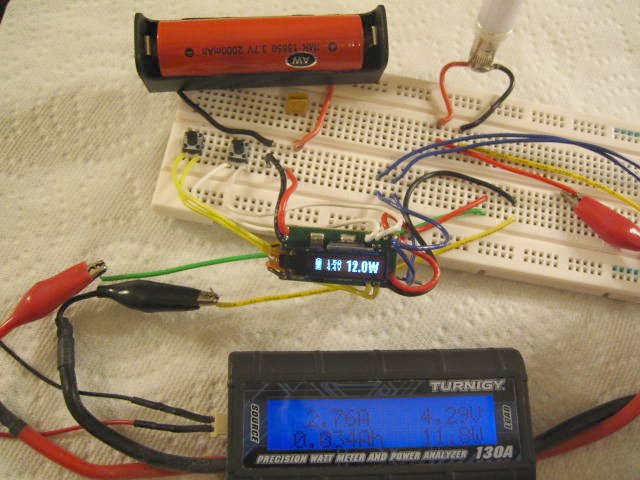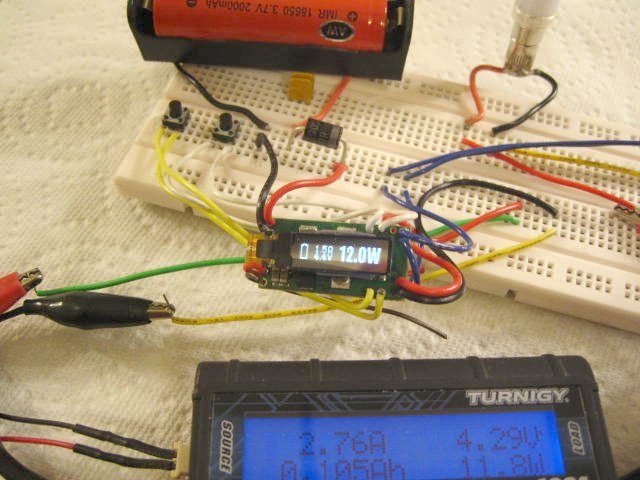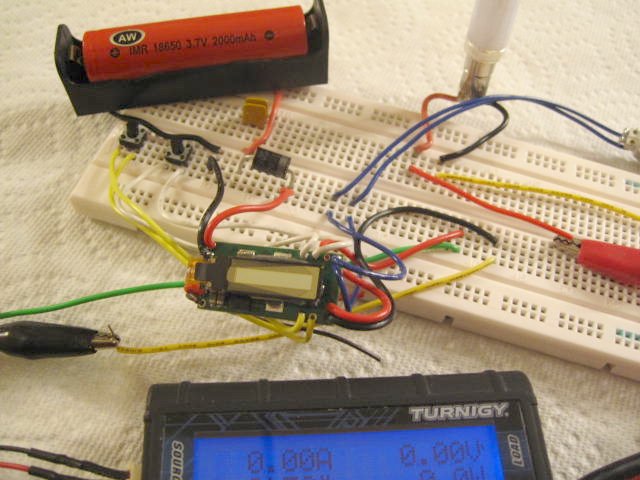I've been tinkering trying to solve this issue with my mods that have user replaceable batts.
Not having much luck so far.
First up - I used a schottky diode. Works great for reverse polarity protection, but is not feasible due to the input voltage drop. With the narrow vaping voltage range we have in our mods, losing .3v - .5v on the input leaves very little vaping time between charges. No problem on the output, just the input. Plus I found a major bugaboo under load.
Here's the DNA20D breadboarded without the diode and in line with a watts meter... I have a fully charged batt... notice no loss of the the batt status bars shown on the display while under load...

Here's the setup with the diode... fully charged batt... notice the severe drain under load as indicated by the drop in batt status bars on the display... you only get a few presses of the fire button before getting check/weak battery - even with a fully charged batt... the forward voltage rating on the diode I used is 0.42v...

Here's the batt inserted backwards and yes, the diode fully protects against reverse polarity. The DNA20D was up and running once I inserted the batt in correctly.

So... no go on the diode due to the loss of input voltage and severe drain under load.
Then I tinkered with a P-FET.
Gate > - input
Drain > + input
Source > + output
Ran into a major problem in that once it was breadboarded and up and running with the P-FET inline, the atty is always firing - with and without pressing the fire button - and when the fire button is pressed, the display shows check atomizer. gawd.
Tried changing the Source to one terminal of the fire button - no go, and then the other terminal of the fire button - no go. I don't know how this is configured on the board, but it created a short as everything got hot hot hot. When I noticed this, I pulled the P-FET and it actually burned my fingers a bit. But the DNA20D still works.
When I was tinkering with touch switches, I had this same issue - the atty always firing with and without pressing the fire button.
Emailed Brandon asking if there is a work around for this, waiting for a reply. Didn't try putting the batt in backwards yet to test the P-FET for reverse polarity protection as saw no reason to if it's not working as is.
Anyone have any other suggestions?
Not having much luck so far.
First up - I used a schottky diode. Works great for reverse polarity protection, but is not feasible due to the input voltage drop. With the narrow vaping voltage range we have in our mods, losing .3v - .5v on the input leaves very little vaping time between charges. No problem on the output, just the input. Plus I found a major bugaboo under load.
Here's the DNA20D breadboarded without the diode and in line with a watts meter... I have a fully charged batt... notice no loss of the the batt status bars shown on the display while under load...

Here's the setup with the diode... fully charged batt... notice the severe drain under load as indicated by the drop in batt status bars on the display... you only get a few presses of the fire button before getting check/weak battery - even with a fully charged batt... the forward voltage rating on the diode I used is 0.42v...

Here's the batt inserted backwards and yes, the diode fully protects against reverse polarity. The DNA20D was up and running once I inserted the batt in correctly.

So... no go on the diode due to the loss of input voltage and severe drain under load.
Then I tinkered with a P-FET.
Gate > - input
Drain > + input
Source > + output
Ran into a major problem in that once it was breadboarded and up and running with the P-FET inline, the atty is always firing - with and without pressing the fire button - and when the fire button is pressed, the display shows check atomizer. gawd.

Tried changing the Source to one terminal of the fire button - no go, and then the other terminal of the fire button - no go. I don't know how this is configured on the board, but it created a short as everything got hot hot hot. When I noticed this, I pulled the P-FET and it actually burned my fingers a bit. But the DNA20D still works.

When I was tinkering with touch switches, I had this same issue - the atty always firing with and without pressing the fire button.
Emailed Brandon asking if there is a work around for this, waiting for a reply. Didn't try putting the batt in backwards yet to test the P-FET for reverse polarity protection as saw no reason to if it's not working as is.
Anyone have any other suggestions?
Last edited:





